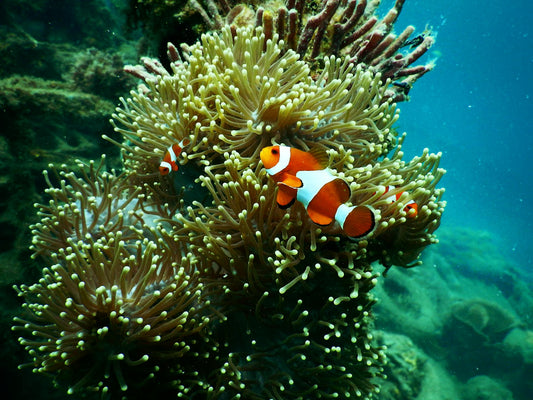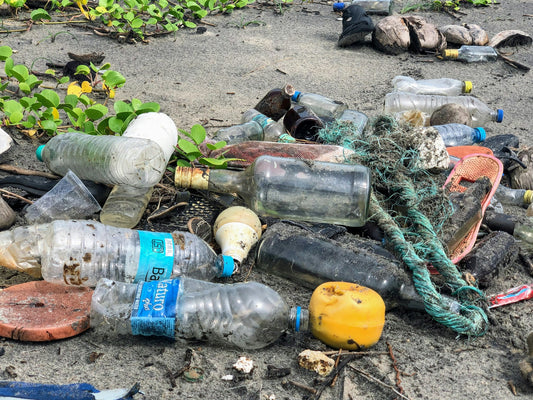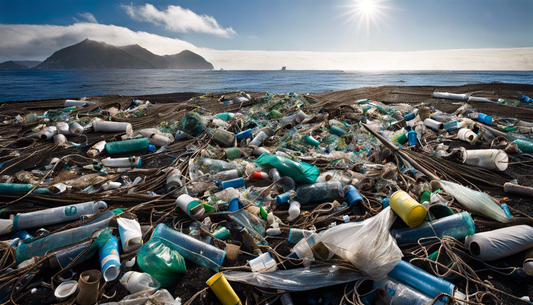Share
The problem of plastic pollution has become one of the most significant environmental issues of the current century, with millions of tons of plastic waste polluting the Earth’s surface and waters.
Coca-Cola is one of the major players that contributed significantly to this crisis.
While the company publicly declares its commitment to sustainability, its environmental impact is still significant.
This blog post focuses on how Coca-Cola contributes to plastic pollution, its manufacturing processes, and its negative environmental impacts.
Coca-Cola is one of the worst culprits of the plastic problem. It continues to manufacture single-use plastics for its products and remains to be the world’s biggest plastic polluter.
Extent of the Problem
In the 2023 brand audits by Break Free From Plastic, plastic waste from 250 brands was collected and analyzed by 8,804 volunteers across 41 countries. These efforts resulted in the collection and auditing of 537,719 pieces of plastic waste.
The Coca-Cola Company topped the list by a long shot. A total of 33,820 items of Coca-Cola-branded plastic waste were found in 40 countries, making it the most prominent contributor to plastic pollution.
Since 2018, over 200,000 volunteers have conducted global cleanups and brand audits in 87 countries and territories to pinpoint the companies most responsible for plastic waste.
Over the five years of these audits, Coca-Cola branded items were consistently the most collected, surpassing the next two top polluters combined. This data solidifies Coca-Cola's position as the leading contributor to global plastic pollution.
Being a beverage company that offers a diverse number of products worldwide, Coca-Cola has been one of the most criticized companies for the excessive use of plastic packaging.
Production of Single-Use Plastics

One of the main reasons behind the sad title of the World's Biggest Plastic Polluter is the production of plastic packaging on a massive scale.
Single-use plastic packaging produced by the company is alarming, standing at 3 million tons per year. To set that into perspective, that means Coca-Cola is producing almost 1% of the global annual plastic production across all sectors and companies.
This accounts for approximately 200,000 bottles being manufactured every minute, which only adds to the already growing problem of plastic pollution around the world.
Most of these bottles, unfortunately, do not end up in recycling centers but rather in landfills or in nature, worsening the pollution of the seas and the deterioration of marine life.
This consistent ranking proves that the company is a major culprit of the growing plastic pollution problem as its products, bottles, cans, and packaging are spotted on beaches, rivers, and other social places across the globe.
Plastic drinking bottles are only the tip of the iceberg of the global plastic epidemic

Explore our plastic-free household products now to protect our nature and make a difference!
Backlash Coca-Cola Has Faced Related to Sustainability
Misleading Marketing Claims

For many years, Coca-Cola has positioned itself as a company that cares about the environment and sustainability, with advertisements supporting causes such as ‘a world without waste’.
The company now says that it is actively moving towards a future that is less detrimental to the environment, including efforts to cut the use of plastics and boost recycling.
However, critics have pointed out that such marketing efforts provide a skewed view of the company’s environmental footprint.
Only recently, The company caused public uproar for sponsoring the UN's most important meeting on climate and sustainability, the United Nations Conference of Parties (COP).
Legal Issues and Consumer Fraud
In 2021, the Earth Island Institute sued Coca-Cola for the company’s misleading ads and promotions.
Specifically, the lawsuit made an assertion that the information that Coca-Cola provided about its plastic bottles being ‘100% recyclable’ was false.
It is actually a fact that many of these bottles, once considered recyclable, actually end up in landfills or incinerators due to ineffective recycling programs.
This is not the case only in the United States; similar concerns have been raised in Europe, where consumers have accused Coca-Cola of giving a wrong impression about the recyclability of packaging materials.
Such legal cases raise a concern about whether the company’s sustainability claims that it has been making are true or whether there is a disconnect between what Coca-Cola says about sustainability and what it does.
Stagnation in Refillable Bottles

Coca-Cola has agreed to raise the level of refillable and reusable bottles to 25% by the year 2030.
However, according to Greenpeace, Coca-Cola is continuously expanding its single-use plastic bottle production by one billion bottles in a single year, putting the current total to unbelievable 100 billion yearly plastic bottles.
Understandably, this has created doubts about the company's genuine intention to fight plastic pollution.
Our Take on How Coca-Cola Can Adopt Circular Economy Principles
The idea of a circular economy is a clear and sensible approach that Coca-Cola could implement to dramatically decrease its impact on the natural environment.
Circular economy revolves around the concept of waste elimination and optimization of the use of resources through recycling, reuse and reduction.
1. Use of Refillable and Reusable Packaging

Refillable and reusable bottles are perhaps the easiest ways for Coca-Cola to implement the circular economy at the moment.
Refillable containers can be collected, washed, and reused over and over again, while single-use plastics are used only once and then disposed of, thus minimizing the need for new supplies and waste.
Interestingly enough, that was already the case a few decades ago, when all Coke bottle were reusable and made of glass.
With the immense Consumer power that Coca-Cola has globally, the company could really make a difference by bringing those reusable bottles back.
2. Increased Collection and Recycling Capabilities
While recycling should always be the last resort, Coca-Cola can use its influence to facilitate the improvement of recycling structures.
This also involves supporting the development of new recycling technologies for mixed plastics and its ability to recycle those plastics back into food-grade packaging.
Also, the company should work with governments and other organizations to establish efficient collection mechanisms, so that as many of these bottles as possible are retrieved and processed for recycling rather than becoming part of the problem of environmental pollution.
3. Redesigning Packaging for Recyclability
To support a circular economy, Coca-Cola can target to design packaging that is easy to recycle.
This entails the use of packaging materials that can be recycled anywhere in the world and the exclusion of packaging that contains several types of materials in one package since it is challenging to disintegrate and recycle.
Reducing the complexity of packaging may help improve the recycling process and its results.
4. Implementing Take-Back Programs

Another strategy is to use take-back programs that enable consumers to return used packaging to Coca-Cola for recycling or reuse.
This can be done through cooperation with retailers or through the points of consumption that are owned by Coca-Cola.
Take-back programs can guarantee that packaging is being picked up and managed in an appropriate manner instead of being dumped.
If you've ever been to Mexico, you may have come across Coca-Cola trucks collecting glass bottles from even the smallest street vendors for refill.
The country has a deposit scheme where bottles get regularly collected and refilled throughout the whole country.
Systems like this prove that circular economy is already possible today, if we really try.
What are your takeaways from this article? Feel free to leave a comment below.
We hope you enjoyed this article. If you want to read more like this, make sure to check out our Blog and follow us on Instagram. If you are interested in truly sustainable products, check out our Shop.








